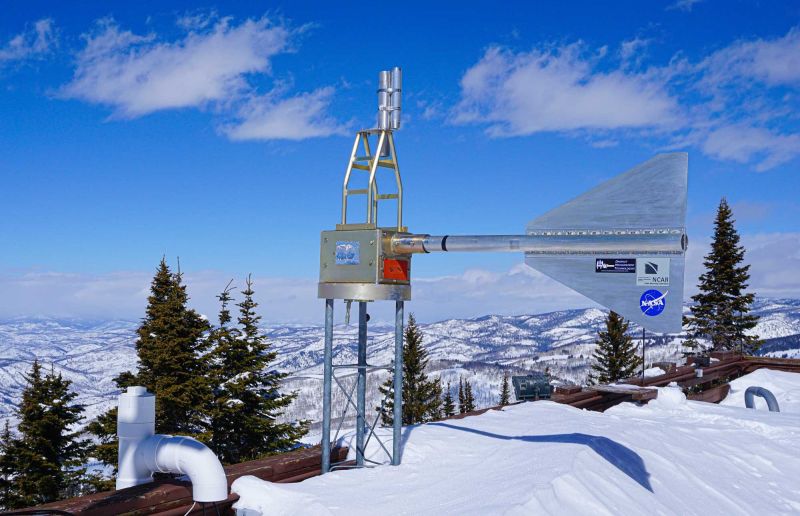Science expeditions in snow, hail and air pollution
Starting this winter through next summer, the U.S. National Science Foundation is supporting three field campaigns, or collaborative research activities, to study atmospheric phenomena. The first will take place in Colorado and focus on snowstorms. Soon after that wraps up, another group of researchers will gather in the Great Plains to study hailstorms. Finally, a team of scientists will take to the skies above New York City to look at air pollution drivers.
Winter snowstorms from a cloudy perspective

Credit: Melissa Dobbins
Claire Pettersen and a group of researchers will spend 4 1/2 months working at a lab atop a Colorado mountain this coming winter as part of an NSF-funded field campaign to improve snowfall forecasts and climate change projections in the western U.S. mountains.
The team includes scientists from multiple universities gathering at NSF-supported Storm Peak Lab, which sits atop Mount Werner next to a chairlift in the Steamboat Ski Resort, about an hour northwest of Denver. "Storm Peak Lab is a really cool place to design a field campaign," Pettersen, a professor at the University of Michigan, said. "The lab actually sits inside a cloud when it snows on the mountain."
The lab's unique location and cutting-edge meteorological instruments make it an ideal location to study how mountains impact winter clouds and snowfall. The upcoming effort, called the Snow Sensitivity to Clouds in a Mountain Environment (S2noCliME) field campaign, will leverage many NSF-funded resources in addition to the lab's instruments, including the Colorado State University Sea-Going Polarimetric Radar, which will help the team study how storms can strengthen or weaken as they move through the region, and the State University of New York at Stony Brook radar observatory, which will help the team investigate cloud and ice particles during a snowstorm.
The team is working with scientists at the NSF National Center for Atmospheric Research (NSF NCAR) to put together a public field catalog that holds its data and observations. The team is also connecting with the community, including the local airport and nearby schools, to share weather forecasts and raise awareness of the campaign. "We want to provide something to the community that's useful," Pettersen said.
Springing into hailstorms in the Plains
After the snow melts and spring turns to summer next year, hail scientist Becky Adams-Selin of the company Atmospheric and Environmental Research, along with 14 collaborating institutions from 11 states and four countries, will spend six weeks in the Great Plains and Front Range studying hailstones falling from the sky.
Hail can destroy buildings and devastate crops. To better understand the science behind the ice, Adams-Selin is leading an upcoming field campaign called In-situ Collaborative Experiment for the Collection of Hail In the Plains (ICECHIP), which will use a variety of instruments and techniques to study hail processes in thunderstorms in the Great Plains and Front Range of the Rocky Mountains.

Credit: Becky Adams-Selin, AER
"It's been a few decades since the last major field campaign focused on hail," Adams-Selin.
ICECHIP plans to make up for the long gap with a multipronged approach. The team will send out four mobile radars to characterize hailstones' physical characteristics, like their size and shape. During a hailstorm, the team will use custom-designed equipment to capture the stones as they fall and redirect them into a cooler. Other plans include creating 3D printed hail models and then using drones to drop them to see how fast they fall.
"Hail science is having a renaissance moment," Adams-Selin said. Not only will this campaign provide valuable data for researchers and weather forecasters, but it will also aid insurance companies trying to set rates and mitigate damage, roofing companies, farmers and other entities affected by hail. "We are very integrated with the people who will use our science," she said.
City air in the summertime
In the height of summer next year, John Mak and a team of researchers will spend four to six weeks studying what happens in the air above and around New York City.
"New York City is a unique environment with a lot of relevance to the American population," Mak, a professor at Stony Brook University, said. "We will fly the NSF NCAR C-130 aircraft and collect gases and particles to study this densely populated area that has a forest to its north, ocean to its south and large urban center in its center." The resulting information will inform future research on ozone and air pollution and provide important information to air quality agencies to help them make decisions on methodologies for mitigating air pollution.
The Greater New York Oxidant, Trace gas, Halogen and Aerosol Airborne Mission (GOTHAAM) will focus on the summer months. The warmer temperatures and longer days make for a unique laboratory setting to see how both urban and natural emissions from surrounding forests and water bodies create unique chemical reactions that can impact air quality and public health.
"You can get a really interesting 'soup' of different kinds of compounds that can change throughout the day," Mak said. "We'll be exploring the interplay among the different pots, looking at how they mix throughout the day and what happens overnight, and how this impacts the next day's chemistry as the sun comes up."
Earth Science Week activities
Whether they're studying snow in Colorado, hail in the Great Plains or air pollution in New York City, NSF-supported scientists are supporting the 2024 Earth Science Week theme, 'Earth Science Everywhere.'
Here are some activities related to each field campaign for K-12 students and educators:
